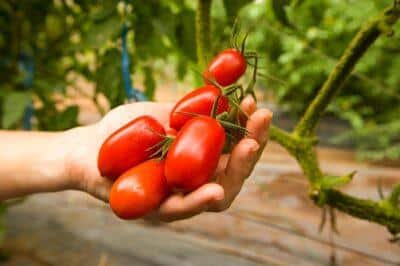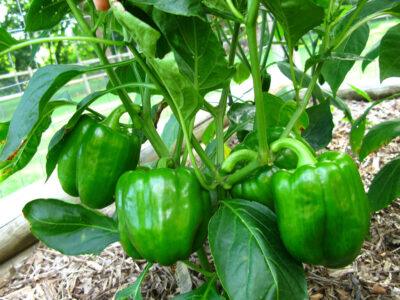Trying to live self-sufficiently in a city or suburban environment is rewarding but comes with many challenges. One of the most common obstacles is simply a lack of space. The average residential lot may vary anywhere from 3,500 square feet. to 6,000 square feet. Either way, even a very large suburban lot isn’t going to be larger than a quarter acre, and often quite smaller.
Fortunately, there are numerous methods to save space and still grow your own food in the city. One of these methods is called edible landscaping.
Edible landscaping is the technique of planting edible foods in place of purely ornamental plants within a landscape. These edible foods could be anything from herbs to full-grown squash plants.
Of course, anyone can use edible landscaping on their property but it works exceptionally well for those who live in an urban setting, for two reasons:
- You can grow food without affecting the value of your current landscape
- It won’t attract unwanted attention from neighbors or passersby
Tight-knit urban communities might not be so happy about you having garden beds on your front lawn. Such a garden also can affect your property value. Additionally, it isn’t unheard of for people in unfortunate situations to help themselves to your food.
Edible landscaping allows you to grow your own food in a subtle but very effective way.
Order your 2015 Heirloom Solutions seed catalog and get $20 in your account!
Planting an Edible Landscape
Edible landscaping tends to be very forgiving and is easy for anyone to do, even if you have no previous experience with gardening. While virtually anything you’d normally plant in a traditional garden can be used in edible landscaping, here are a few that work very well in this type of set-up:
1. Sweet and hot peppers. They fare well against pests, and most plants are quite attractive. They also give a ton of color variety since peppers go through a color change as they grow.
2. Beans. Bean plants are vining in nature and can grow quite large. They are great for covering a trellis, and bean plant flowers are very attractive.
3. Herbs. Herbs are a real win-win. Not only do they save you money (dried and fresh herbs are expensive), but many varieties like mint are super hardy and make a good ground cover.
4. Berry bushes. Berries are delicious, and the shrubs they grow in can be used as a hedge for privacy or in place of a fence. Actually, thorned shrubs can be quite a deterrent for keeping stray animals (and people) away.
5. Flowering kale. Some flowering kale species don’t even look like they should be in a garden. Regular kale and dinosaur kale can work very well, too, and often taste better than flowering kales.
6. Ornamental cabbage. Just like flowering kales, ornamental cabbage varieties can be downright stunning. They tend to not be as tasty as commercial varieties but they are still edible.
7. Tomatoes. While being one of the most commonly grown vegetables, tomatoes also can work flawlessly in edible landscaping. The fruits aren’t just red, but can come in colors like chocolate to purple and even have patterns like stripes.
8. Swiss chard. This vegetable tastes delicious and is very colorful without sacrificing taste. Normally, Swiss chard has a vivid red stalk but other varieties come in a mix of yellow, pink and orange. The leaves can also vary in color from green to deep purple.
9. Rhubarb. Another plant with delicious red stalks like Swiss chard. Rhubarb stalks are edible but the leaves should not be eaten by people and animals.
10. Edible flowers. This is a given, but if you’re planting an edible landscape you can’t go wrong with edible flowers.
Get Delicious, Nutrient-Dense Heirloom Seeds Here!
Planning Your Edible Landscape
It is a great idea to start planning your edible landscaping during winter so you have plenty of time to draw out a plan, order your seeds and start them indoors in time for spring planting.
Even though you may get away with going straight to digging and planting, it isn’t advisable.
Step 1: Review Your Property and Draw a Basic Layout
The first step in planning is to take a good look at the land you have to work with. Taking pictures is very helpful, as well. You will also want to draw a layout of your lot that accounts for your house, any outbuildings and structures that are permanent. You will also want to draw in any landscaping you have that you don’t want to remove.
*Note: A great way of getting an overhead view of your property that will show your current landscape is to use Google Maps. You can then trace your lot or each section you want to landscape onto graph paper.*
This page is a great resource if you have never drawn an in-scale outline for landscaping.
Step 2: Find Your Zone and Learn Your Property’s Peculiarities
If you don’t already know your zone, you can visit this website and enter your zip code to find out what it is. This is going to be very important in the next step.
Next, go take a walk around your property and makes notes of any peculiarities. For example, what areas are totally shaded, partially shaded or have full sun? Which areas tend to collect water and pool after a storm? Which areas already have competing shrubs, plants or trees?
You really want to closely examine your property so you can create a thorough plan of what edibles you want to add. For example, if you want to grow an herb that prefers shade, you will know exactly where on your property it will thrive.
Step 3: Make a List of Vegetables, Herbs, Fruits and Trees You Want
Now for the fun part. You can look online or flip through seed catalogs and start making a list of what you want to plant. It is really easy to go overboard and end up with a giant list you couldn’t possibly plant on your lot.
Instead, think of what foods you buy most often from the grocery store. Maybe you and your family are big salad eaters. You’d benefit a lot from growing different salads and leafy vegetables.
If you plan on planting trees, keep in mind how large they could possibly grow and how quickly. The same goes for large bushes or shrubs. They could grow more quickly than you imagined and end up shading your once-sunny spots.
It is also a really good idea to not just account for the space each plant will need but also leave gaps for future planting. Remember: You can always add more plants in empty spaces.
When it comes to planting your edible landscaping, it is just like planting a garden. All of the same principles apply.
You can check out further resources and edible landscape ideas here:
- Edible Landscaping Basics Article
- Designing Your Edible Landscape Article
- 7 Edible Garden Design Ideas Slideshow
- Edible Landscaping For The Lazy Survival Gardener
Have you considered edible landscaping? Maybe you already practice it at your home? Share any questions or comments below!
 Off The Grid News Better Ideas For Off The Grid Living
Off The Grid News Better Ideas For Off The Grid Living






